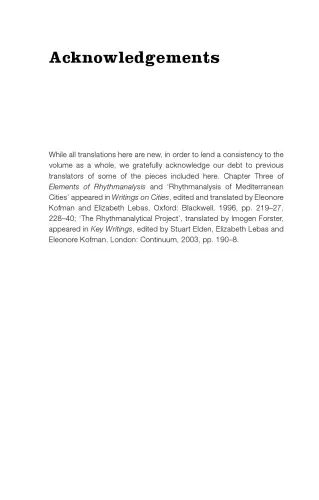Rhythmanalysis: Space, Time and Everyday Life
4.6
Reviews from our users

You Can Ask your questions from this book's AI after Login
Each download or ask from book AI costs 2 points. To earn more free points, please visit the Points Guide Page and complete some valuable actions.Analytical Summary
Henri Lefebvre’s Rhythmanalysis: Space, Time and Everyday Life stands as an essential contribution to the fields of urban sociology and spatial theory, offering a penetrating lens on how rhythms—social, spatial, and temporal—structure human experience. Through a methodology that bridges philosophy, cultural theory, and the lived reality of modern spaces, Lefebvre invites readers to detect, interpret, and engage with the multifaceted temporal patterns shaping everyday life.
Published as part of Lefebvre’s final philosophical explorations (original French edition: Information unavailable due to no reliable public source), the text expands his long-standing project of understanding space, not as static backdrop, but as dynamic and rhythmic. Co-edited and introduced in its English edition by Stuart Elden, with translation by Gerald Moore, it distills decades of thinking into an accessible yet challenging set of reflections.
The book merges analytical precision with lyrical observation, guiding the reader across urban landscapes, notes of music, cycles of nature, and the flow of human interaction. It argues that rhythms—whether the beat of a city’s traffic or the ebb of social routines—are both a product and a producer of spatiality and temporality. This perspective offers invaluable tools for academics, urban planners, and cultural theorists seeking a deeper grasp of how life organizes around time and space.
Key Takeaways
The book delivers several important insights that resonate across disciplines, urging serious readers to reconsider conventional approaches to space and time.
First, rhythms permeate all aspects of life, from bodily cycles to city infrastructures, and are critical to understanding social phenomena. Second, spatial theory benefits from integrating temporal analysis, revealing how spaces are constantly created and recreated through everyday rhythms. Third, the practice of “rhythmanalysis” is not abstract; it is a practical skill for better interpreting the pulse of urban and rural environments alike. Finally, Lefebvre offers a compelling framework for identifying harmony or discord in societal flows, allowing experts in sociology, architecture, and geography to diagnose and imagine possibilities for transformation.
Memorable Quotes
Lefebvre’s prose is charged with observations that linger, pointing to the richness and complexity of everyday rhythms.
“Everywhere where there is interaction between a place, a time and an expenditure of energy, there is rhythm.” Unknown
“Rhythms are not simply objects of study; they are a way of grasping life.” Unknown
“Understanding the city begins with learning to listen to its rhythms.” Unknown
Why This Book Matters
Rhythmanalysis: Space, Time and Everyday Life matters because it connects theory with lived reality, offering a structural approach to phenomena often overlooked—the symphony of rhythms shaping our interaction with space and time.
For professionals and academics, this work acts as both guide and challenge: it demands attentiveness, interdisciplinary thinking, and methodological innovation. Urban sociologists find themselves equipped to analyze cities beyond mere statistics, while spatial theorists discover a temporal dimension too critical to ignore. Lefebvre’s emphasis on applied observation means the book extends relevance beyond the academy to areas like sustainable urban design, cultural analysis, and even personal time management.
Inspiring Conclusion
Reading Rhythmanalysis: Space, Time and Everyday Life is not merely an academic exercise—it is a transformative experience that reframes how we perceive our surroundings.
By training ourselves to feel and interpret rhythms, we open possibilities for more harmonious living, more responsive urban design, and deeper cultural insight. Lefebvre’s method invites each reader to become a rhythmanalyst in their own right, attuned to the subtleties of temporal flow in spatial contexts. Whether you apply these insights to scholarly research, professional practice, or your daily routines, the book’s value lies in its capacity to sharpen perception and inspire action. Now is the time to engage with its ideas—read, share, and discuss them, ensuring the rhythms of thought continue to evolve.
Free Direct Download
You Can Download this book after Login
Accessing books through legal platforms and public libraries not only supports the rights of authors and publishers but also contributes to the sustainability of reading culture. Before downloading, please take a moment to consider these options.
Find this book on other platforms:
WorldCat helps you find books in libraries worldwide.
See ratings, reviews, and discussions on Goodreads.
Find and buy rare or used books on AbeBooks.
1010
بازدید4.6
امتیاز50
نظر98%
رضایتReviews:
4.6
Based on 0 users review
"کیفیت چاپ عالی بود، خیلی راضیام"
Questions & Answers
Ask questions about this book or help others by answering
No questions yet. Be the first to ask!


